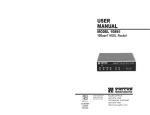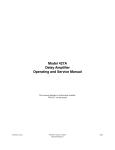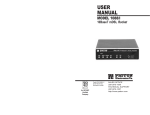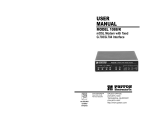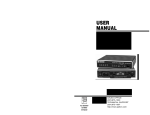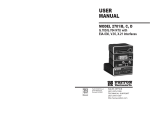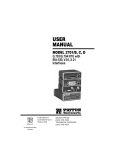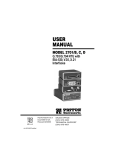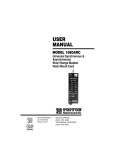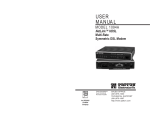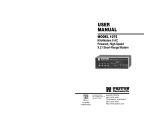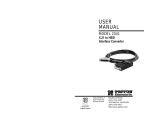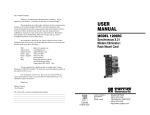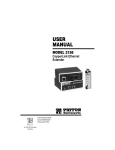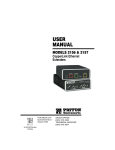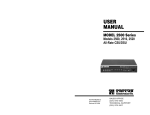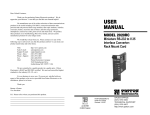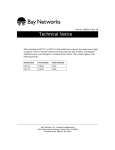Download USER MANUAL
Transcript
USER MANUAL MODEL 1089 C and D HDSL Modem with V.35 or X.21 Interface Part# 07M1089/C-B Doc# 033121UB Revised 03/13/00 CERTIFIED An ISO-9001 Certified Company SALES OFFICE (301)975-1000 TECHNICAL SUPPORT (301)975-1007 http://www.patton.com 1.0 WARRANTY INFORMATION TABLE OF CONTENTS Section Page 1.0 Warranty Information .............................................................2 1.1 Radio and TV Interference 1.2 CE Notice 1.3 Service 2.0 General Information...............................................................4 2.1 Features 2.2 Description 3.0 Configuration .........................................................................5 3.1 Configuring the Hardware DIP Switches 3.1.1 Configuration DIP Switch Set “S2” 3.1.2 Configuration DIP Switch Set “S3” Patton Electronics warrants all Model 1089 components to be free from defects, and will—at our option—repair or replace the product should it fail within one year from the first date of shipment. This warranty is limited to defects in workmanship or materials, and does not cover customer damage, abuse or unauthorized modification. If this product fails or does not perform as warranted, your sole recourse shall be repair or replacement as described above. Under no condition shall Patton Electronics be liable for any damages incurred by the use of this product. These damages include, but are not limited to, the following: lost profits, lost savings and incidental or consequential damages arising from the use of or inability to use this product. Patton Electronics specifically disclaims all other warranties, expressed or implied, and the installation or use of this product shall be deemed an acceptance of these terms by the user. 1.1 RADIO AND TV INTERFERENCE 4.0 Installation ...........................................................................10 4.1 Connecting the Twisted Pair Interface 4.2 Connecting the Model 1089/C (V.35) Serial Interface 4.2.1 Connecting the Model 1089/C to a DTE Device 4.2.2 Connecting the Model 1089/C to a DCE Device 4.3 Connecting the Model 1089/D (X.21) Serial Interface 4.3.1 Connecting the Model 1089/D to a DCE or DTE Device 4.3.2 Opening the Case 4.4 Connecting Power 4.4.1 Universal Power (100 - 240VAC) 4.4.2 120VAC Power (US) 4.4.3 230VAC Power (International) 4.4.4 48VDC Power 5.0 Operation .............................................................................15 5.1 Power-Up 5.2 LED Status Monitors 5.2.1 LED Descriptions Chart 5.3 Test Modes 5.3.1 Overview 5.3.2 Loops and Patterns 5.3.3 Using the V.52 (BER) Test Pattern Generator Appendix Appendix Appendix Appendix A - Specifications........................................................26 B - Factory Replacement Parts and Accessories.......27 C & D - Interface Pin Assignments.............................28 E - Transmission Distance Chart................................30 1 The Model 1089 generates and uses radio frequency energy, and if not installed and used properly—that is, in strict accordance with the manufacturer's instructions—may cause interference to radio and television reception. The Model 1089 has been tested and found to comply with the limits for a Class A computing device in accordance with the specifications in Subpart J of Part 15 of FCC rules, which are designed to provide reasonable protection from such interference in a commercial installation. However, there is no guarantee that interference will not occur in a particular installation. If the Model 1089 does cause interference to radio or television reception, which can be determined by disconnecting the unit, the user is encouraged to try to correct the interference by one or more of the following measures: moving the computing equipment away from the receiver, re-orienting the receiving antenna and/or plugging the receiving equipment into a different AC outlet (such that the computing equipment and receiver are on different branches). 1.2 CE NOTICE The CE symbol on your Patton Electronics equipment indicates that it is in compliance with the Electromagnetic Compatibility (EMC) directive and the Low Voltage Directive (LVD) of the European Union (EU). A Certificate of Compliance is available by contacting Technical Support. 2 2.0 GENERAL INFORMATION 1.3 SERVICE All warranty and non-warranty repairs must be returned freight prepaid and insured to Patton Electronics. All returns must have a Return Materials Authorization number on the outside of the shipping container. This number may be obtained from Patton Electronics Technical Service at: Thank you for your purchase of this Patton Electronics product. This product has been thoroughly inspected and tested and is warranted for One Year parts and labor. If any questions or problems arise during installation or use of this product, please do not hesitate to contact Patton Electronics Technical Support at (301) 975-1007. 2.1 FEATURES tel: (301)975-1007 email: [email protected] www: http://www.patton.com NOTE: Packages received without an RMA number will not be accepted. Patton Electronics' technical staff is also available to answer any questions that might arise concerning the installation or use of your Model 1089. Technical Service hours: 8AM to 5PM EST, Monday through Friday. IMPORTANT: The Model 1089 is equipped with flash upgrade. Please refer to Patton website, or contact Technical Support for the latest version of the software. • • • • • • • • • • High Bit-Rate DSL 2B1Q Modulation DTE Rates up to 1.154Mbps V.35 and X.21 Interfaces Interoperable with Popular Model 1094A SNMP Manageable via 1001MC SNMP Agent Rack Card through 1094RC/CO Universal Power Options, 120VAC, 230VAC and -48VDC Available Front Panel Status Indicators Small, Convienent Desktop Unit CE Marked 2.2 DESCRIPTION The Patton Electronics HDSL Rocket provides high speed 2wire connectivity to ISPs, PTTs, and corporations using HDSL (Multirate Symmetric Digital Subscriber Line) technology. Supporting multiple line rates from 144kbps to 1.168Mbps, the NetLink provides “megabyte” speeds to leased line, LAN to LAN interconnection, and WAN access networks over 3.6 miles/5.8km (1.054Mbps on 24AWG/.5mm wire). Model 1089/C provides a V.35 interface on an M/34 female connector. Model 1089/D provides an X.21 interface on a DB-15 female connector. Features include loopback diagnostics, inband SNMP/HTTP remote management capabilities through 1094RC/CO and externally accessible configuration switches. All versions of the Rocket are compatible with Patton’s popular Model 1094A standalone and 1094ARC rack card. As a symmetric DSL NTU, NetLinkTM mDSL offers the same data rates in both directions over a single pair of regular telephone lines using 2B1Q modulation. Line connection is made by an RJ-45 jack. Standard versions of Model 1089 are powered by a 100/230VAC(Universal) supply. The DC power supply option supports any DC input between 36-72VDC. 3 4 3.0 CONFIGURATION 3.1.1 Configuration DIP Switch Set “S2” The Model 1089 is equipped with two sets of eight DIP switches, which allow configuration of the unit for a wide variety of applications. This section describes switch locations and explains all possible configurations. The configuration switches on S2 allow you to specify the Clocking Mode and to enable/disable Local and Remote Loop requests from the V.35 DTE. Default settings of S2 are shown in the table below. 3.1 CONFIGURING THE HARDWARE DIP SWITCHES The 16 external switches are grouped into two eight-switch sets, and are externally accessible from the underside of the Model 1089 (See Figure 1). Front Position S2-1 S2-2 S2-3 S2-4 S2-5 S2-6 S2-7 S2-8 S2 SUMMARY TABLE Function Reserved Reserved Reserved Reserved Reserved Clock Mode Clock Mode Enable Loop from DTE Factory Default Off Off Off Off On On Receive Off Recover Off Disabled S2 Switch S2-1, S2-2, S2-3, S2-4, and S-5: S3 Reserved for factory use and must remain in the OFF position. Off On Switches S2-6 and S2-7: Clock Mode Use Switches S2-6 and S2-7 to configure the 1089 for internal, external, or receive recover clock mode. Back Figure 1. Underside of Model 1089, Showing Location of DIP Switches The two sets of DIP switches on the underside of the Model 1089 will be referred to as S2 and S3. As Figure 2 shows, the orientation of all DIP switches is the same with respect to “ON” and “OFF” positions. ON OFF CO/CP Unit CO S2-6 On CO CP S2-7 On Clock Mode Internal Description Transmit clock generated internally Off On External (DTE) Transmit clock derived from terminal interface On Off Receive Recover Transmit clock derived from the received line Off Off Figure 2. Close Up of Configuration Switches (all sets are identical in appearance) 5 Reserved 6 Switch S2-8: Enable/Disable Loop Tests from DTE Switch S2-8 may be used to allow Model 1089/C to enter loopback diagnostic tests (Local or Remote) when the V.35 DTE raises the appropriate loop request pin (LLB: Pin L or RDL: Pin N). When Switch S2-8 is in the On position, the Model 1089/C will enter Local Loopback or Remote Loopback at the request of the DTE. When Switch S2-8 is in the Off position, the Model 1089/C ignores DTE loop requests. In the Off position, loop requests may still be initiated by the front panel switch. S2-8 On Off 3.1.2 Configuration Switch Set “S3” Use the eight DIP Switches in Switch S3 to enable the DTE bit rate. The following table summarizes default positions of DIP Switch S3. Detailed descriptions of each switch follow the table. Position S3 SUMMARY TABLE Function S3-1 DTE Rate On S3-2 DTE Rate Off S3-3 DTE Rate Off S3-4 DTE Rate Off S3-5 DTE Rate On S3-6 DTE Rate On S3-7 Reset Software Defaults On Normal Operation S3-8 Transmit Data Sample Point On Normal Operation Setting DTE Loopback Request Enabled DTE Loopback Request Disabled Factory Default } 768 kbps Switch S3-1: DTE Rate Use Switch S3-1 through S3-6 to set the DTE bit rate. S3-1 Off On Off On Off On Off On Off On Off On Off On Off On Off On 7 S3-2 Off On On Off Off On On Off Off On On Off Off On On Off Off On S3-3 On Off Off Off Off On On On On Off Off Off Off On On On On Off S3-4 On On On On On Off Off Off Off Off Off Off Off On On On On On S3-5 On On On On On On On On On On On On On Off Off Off Off Off 8 S3-6 On On On On On On On On On On On On On On On On On On DTE Rate (kbps) 64 128 192 256 320 384 448 512 576 640 704 768 832 896 960 1024 1088 1152 4.0 INSTALLATION NOTE: Based on the DTE rate chosen, the Model 1089 will automatically select the optimum line rate depending on distance and line conditionsfor the distance. The line selection will be based on the lowest line rate that will support the DTE rate. Once the Model 1089 is properly configured, it is ready to connect to the twisted pair interface, to the serial port, and to the power source. This section tells you how to make these connections. Switch S3-7: Reset Software Defaults 4.1 CONNECTING THE TWISTED PAIR INTERFACE Switch S3-7 allows the user to reset the software configured factory defaults. This will only be needed when using the Model 1001MC to SNMP manage your units. For more information, please refer to the Model 1001MC Operations Manual. The Model 1089 supports communication between two DTE devices at distances to 5 miles (8 km) over 24 AWG (.5mm) twisted pair wire. Two things are essential: S3-7 On Off 1. These units work in pairs. Both units at the end of the twisted pair DSL span must be set for the same DTE rate. Setting Normal Operation Reset 2. Switch S3-8: Transmit Data (TD) Sampling Point Switch 3-8 controls the Transmit Data (TD) sampling point. S3-8 On Off Setting Normal Description TD sampled on the falling edge of the 1089 Transmit Clock (TC) Invert TD sampled on the rising edge of the 1089 Transmit Clock. To function properly, the Model 1089 needs one twisted pair of metallic wire. This twisted pair must be unconditioned, dry, metallic wire, between 19 (.9mm) and 26 AWG (.4mm) (the higher number gauges will limit distance). Standard dial-up telephone circuits, or leased circuits that run through signal equalization equipment, or standard, flat modular telephone type cable, are not acceptable. The RJ-45 connector on the Model 1089’s twisted pair interface is polarity insensitive and is wired for a two-wire interface. The signal/pin relationships are shown in Figure 3 below. 1 2 3 4 5 6 7 8 1 2 3 4 5 6 7 8 (N/C) (N/C) (N/C) (2-Wire TIP) (2-Wire RING) (N/C) (N/C) (N/C) Figure 3. Model 1089 RJ-45 twisted pair line interface. IMPORTANT!: The Model 1089 has been optimized for performance at high bitrates (DTE rates greater than 512 kbps). To ensure accurate performance at these bit rates, please use twisted pair line interface cable that is at least 330ft (100m) in length. 9 10 4.2 CONNECTING THE MODEL 1089/C (V.35) SERIAL INTERFACE 4.3 CONNECTING THE MODEL 1089/D (X.21) SERIAL INTERFACE Model 1089/C supports V.35 serial port connections. This section describes how to connect the serial ports to your V.35 equipment. Model 1089/D supports X.21 serial port connections. This section describes how to connect the serial ports to your X.21 equipment. 4.2.1 Connecting the Model 1089/C (V.35) to a “DTE” Device 4.3.1 Connecting the Model 1089/D (X.21) to a “DCE” or “DTE” Device The Model 1089/C provides a V.35 DCE (Data Circuit Terminating Equipment) interface on an M/34 female connector. As a DCE, this interface is designed to connect to DTE equipment, such as a router. When connecting the V.35 interface of the Model 1089/C to your DTE device, use a V.35 straight through cable (See Figure 4, below). Appendix C describes pin assignments and signal sources for the Model 1089/C V.35 interface. When purchasing or constructing an interface cable, please refer to the pin diagrams in Appendix C as a guide. The Model 1089/D provides an X.21 interface on a DB-15 female connector. The X.21 interface default configuration is DCE (Data Circuit Terminating Equipment) for connection to DTE (Data Terminal Equipment) such as a router. However, the X.21 interface on the Model 1089/D may be configured as DTE (Data Terminal Equipment) for connection to DCE such as a modem or multiplexer. When connecting the X.21 interface of the Model 1089/C to your DTE device, use a X.21 straight through cable (See Figure 6, below). DSL Span Remote Model 1089) Straight-Through M/34 Cable Model 1089/C (DCE) Router (DTE) with V.35 Serial Interface DSL Span Remote Model 1089) Straight-Through 15-pin D-Sub Cable Router (DTE) OR Mux (DCE) Model 1089/D (DCE or DTE) Figure 4. Connecting the Model 1089/C to V.35 Serial DTE 4.2.2 Connecting the Model 1089/C (V.35) to a “DCE” Device The Model 1089/C provides a V.35 (Data Circuit Terminating Equipment) interface on an M/35 female connector. As a DCE, this interface is designed to connect to DTE equipment, such as a router. However, tail-circuit applications require connection to another DCE equipment, such as a multiplexer. When connecting the V.35 interface of the Model 1089/C to your DCE device, use a V.35 null modem cable. Some applications may also required the installation of a V.35 tail-circuit buffer to account for small differences in clock frequency between the 1089/C and the V.35 DCE (multiplexer). DSL Span Remote Model 1089 Figure 6. Connecting the Model 1089/D to X.21 DTE or DCE To modify the DCE/DTE orientation from the default position (DCE), you must open the Model 1089/D case. 4.3.1 Opening the Case To open the Model 1089/D case, insert a flat head screw driver into an open slot on both sides of the case, as in Figure 7. Twist the screw driver head slightly and the top half of the case will separate from the lower half, as in Figure 7, below. Take caution not to damage of the pc-board mounted components. Model 1089/C (DCE) V.35 Multiplexer (DCE) Figure 5. Connecting the Model 1089/C to V.35 Serial DCE 11 Figure 7. Opening the 1089 Case with a Small Screwdriver 12 The DCE/DTE strap is located on the top side of the 1089/D pc board (See Figure 8, below). The arrows on the top of the strap indicate the configuration of the X.21 port (for example, if the DCE arrows are pointing toward the DB-15 connector, the X.21 port is wired as a DCE). Change the DCE/DTE orientation by pulling the strap out of its socket, rotating it 180º, then plugging the strap back into the socket. You will see that the DCE/DTE arrows now point in the opposite directions, showing the new configuration of the X.21 port. To close the case, fit the 2 halves together snugly and snap them back in place. 4.4.2 120 VAC Power (US) The 100-132 VAC adapter supplied with the U.S. version of the Model 1089 is a wall mount type and may be plugged into any approved 120 VAC wall jack. 4.4.3 230 VAC Power (International) The 230 VAC adapter supplied with the International version of the Model 1089 is a wall mount type and may be plugged into any approved 230 VAC wall jack. 4.4.4 DC Power DB-15 Connector DCE/DTE Strap The 36-60 VDC DC to DC adapter supplied with the DC version of the Model 1089 plugs in a DC source (nominal 48VDC) and plugs into the barrel power supply jack on the rear of the 1089/I. Please refer to Figure 9, below, to make the proper connection. To Power Supply Jack To -48VDC Source -Vin +Vin Figure 8. Setting the DCE/DTE Strap 4.4 CONNECTING POWER The Model 1089 (all versions) are available with Universal AC (100-240VAC), 120VAC, 230VAC or -48VDC power options. This section describes these options. 4.4.1 Universal AC Power (100-240VAC) Figure 9. Connecting DC Power to the 48V-PSM DC Power Supply. WARNING! There are no user-serviceable parts in the power supply section of the Model 1089. Fuse replacement should only be performed by qualified service personnel. Contact Patton Electronics Technical support at (301)9751007, via our web site at http://www.patton.com, or by e-mail at [email protected], for more information. The Model 1089 uses a 5VDC, 2A universal input 100-240VAC, power supply (center pin is +5V). The universal input power supply has a male IEC-320 power entry connector. This power supply connects to the Model 1089 by means of a barrel jack on the rear panel. Many international power cords are available for the universal power supply (Please refer to Appendix B for country-specific power cords. The Model 1089 powers up as soon as it is plugged into an AC outlet--there is no power switch. 13 14 5.0 OPERATION - Only at power up, blinks once every 200 ms if the DTE Rate is set to an unsupported settings Once the Model 1089 is properly configured and installed, it should operate transparently. This sections describes power-up, reading the LED status monitors, and using the built-in loopback test modes. TM glows yellow to indicate that the Model 1095 has been placed in Test Mode. The unit can be placed in test mode by the local user or by the remote user. The TM LED will flash for 400msec when a valid packet is received from the Model 1001MC. 5.1 POWER-UP To apply power to the Model 1089, first be sure that you have read Section 4.4. The unit powers up when it is plugged into the power source. 5.2.1 Model 1089 LED Descriptions Chart 5.2 LED STATUS MONITORS The Model 1089 features six front panel LEDs that monitor power, the DTE signals, network connection and test modes. Figure 10 (below) shows the front panel location of each LED. Following Figure 10 is a description of each LEDs function. See also, section 5.2.1 Model 1089 LED Descriptions Chart NetLink X.21 HDSL Rocket DSL Link TD RD NS ER TM Local Normal Remote - - 511E - Normal - 511 Figure 10. Model 1089 Front Panel DSL Link (Active Green) Solid green (On) indicates that the end to end DSL Framer Link is up, signifying that the link across the DSL span is active. The DSL Link LED is Off when the link is down. TD & RD Glows yellow to indicate an idle condition of Binary “1” data on the respective terminal interface signals. Green indicates Binary “0” data NS (No Signal) glows red to indicate that the local Model 1089 is not connected with the remote Model 1089. ER- blinks ON/OFF after a 511/511E test has timed out. See Section 5.3.3 (Test Pattern Generator) for more information. - flashes once to indicate that a CRC error has occurred (during normal operation) or bit errors have occurred (during 511/511E tests). 15 Clock (CO) Internal 768Kb No DTE TD RD DSL NS ER TM Clock (CP) R/R No DTE TD RD DSL NS ER TM Power ON G O off ON off off O O off DSL Link G O G off off off O G G Link Brk G O off off off off O O off off Brk+ 10s G G off ON off off O O off ON RDL G G G off off ON O G off off ON G G off O G off off off ON RDL+511 off off ON With DTE Connected G ON off off off off off off off off off With DTE Connected Mark O O G off off off O G off off off Space G G G off off off G O G G off off off Data GO GO G off off off GO GO G off off off Link Brk = DSL Link Broken Brk+10s = 10 Seconds following Link Break G=GREEN O=ORANGE ON= ON off= OFF Y=yellow 5.3 TEST MODES The Model 1089 offers two proprietary loopback test modes, plus a built-in V.52 BER test pattern generator to evaluate the condition of the modems and the communication link. These tests can be activated physically from the front panel or via the DTE interface. 5.3.1 Overview Figure 11 shows the major elements used in the loop-back and pattern tests available in the Model 1089. Each block has several functions. Following Figure 11 are descriptions that show how the elements are used during Test Modes. 16 Framer Pattern Gen/Det Loop Control Line Processor Loop Control Pattern Gen/Det Restart Procedure and Time Outs Framer Processor Figure 11: Block Diagram Model 1089 Framer Pattern Gen/Det Loop Control The framer is used to determine the status of the line. In normal operation the framer transmits and expects to receive framed packets from the far end. If the framer receives framed packets from the far end, CTS and CD will be active. If framed packets are not received, CTS and CD will be inactive. The restart procedure uses this information to determine if a valid connection is made (cable disconnect, poor cable quality, etc). In normal Data Mode, if the Model 1089 receives 4 seconds of unframed packets it will restart and begin trying to re-establish a connection with the far end. The distinction between framed packets and unframed packets becomes important when we discuss the Pattern Generator. This part of the Processor generates and detects the 511/511E patterns. When transmitting 511 patterns, the information is unframed (because it originates after the framer) and is intended to be evaluated only by another Processor. If the units are in Data Mode and the pattern generator is enabled on one end of the link, the far end will begin receiving unframed packets and assume that the line has gone down. During test modes, we force the pattern generator to time out before it can cause the link to be killed. Item The restart procedure is in place to allow the units to re-establish a connection after the framer begins seeing unframed packets. The Test Model Timing Chart below shows the amount of time the framer must see consecutive unframed packets before the unit will restart and try to establish a new line connection. The reason that there are different Restart Times will become apparent after reading the rest of the document. The 511/511E Time Out shown refers to the amount of time the 511/511E pattern will be valid. At the end of this time the pattern will automatically turn itself off and the normal data path will be re-established. The ER led will flash indicating to the user that the test has timed out. The ER led will stop flashing once the 511/511E switch is placed into the normal position. Test Mode Timing Elapsed Time (seconds) Start Up Data Mode 511/511E Generator Enabled Remote End of an RDL 511/511E Time Out 50 4 60 (The generator will stop after 45 seconds.) 60 45 (The pattern generator will automatically turn off after 45 seconds. The ER LED will flash until the user turns off the 511/511E switch.) Symbol Indicators This symbol designates the origination or the termination of a data path. The direction of the arrow connected distinguish the two data paths. This symbol designates an invalid data path. If there is data present it should be ignored. This part of the Processor is used to control loop-backs. In a Local Loop, the data is looped back towards the local DTE. In a Remote Loop, the data is looped back to the line, but it is also allowed to pass through to the framer and to the remote DTE. 17 18 5.3.2 Loops and Patterns The following section describes the Test Modes used in the Model 1089. At the bottom of each Test Mode, a figure is included to show the data path. Framer Pattern Gen/Det Loop Control Loop Control Line Processor Local Loop There are two different modes of operation for a Local Loop depending on the status of the units at the time that the Local Loop is initiated. If the units are not in linked (NS LED on) and the Local Loop is initiated, either by the front panel switch or the DTE interface, the unit will enter mode 1. If the units are linked, NS LED off, then the unit will enter a mode 2 Local Loop. A Mode 1 Local Loop is shown in Figure 7. When the Local Loop is initiated, either by the front panel switch or the DTE interface, the loop will be activated within the local Processor. The data present at the local DTE interface will be looped back to the local DTE by the Loop Control block within the Processor. Any data present on the line or at the far end DTE interface is invalid. The remote unit will remain in the StartUP mode, NS LED on, CTS LED yellow, and CD LED yellow, until the local unit is taken out of the Local Loop mode. After the Local Loop is deselected, the units will both be in StartUP mode and the link will be established. A mode 2 Local Loop is shown in Figure 8. When the Local Loop is initiated, either by the front panel switch or the DTE interface, two separate loop paths will be started. In the first path, data presented to the local DTE interface will be looped back to the local DTE within the framer. In the second path, data presented at the far end DTE will be transmitted to the local DTE and then looped back within the local DTE Loop Control block with the Processor. After the Local Loop is deselected, the units will be placed back into DataMode and the normal data paths will be re-established. 19 Pattern Gen/Det Framer Processor Figure 12. Block Diagram Local Loop Mode 1 Framer Pattern Gen/Det Loop Control Line Loop Control Processor Pattern Gen/Det Framer Processor Figure 13. Block Diagram Local Loop Mode 2 Local Loop with 511/511E When the unit is placed into a Mode 1. Local Loop and the 511/511E pattern generator is activated, the local pattern generator begins sending out a 511/511E pattern to the Loop Control block. The Loop Control block will loop this data back to the 511/511E pattern detector block, which will evaluate the data for errors. Because the 511/511E pattern generator is contained within the Processor the data is unframed so the framer will begin seeing unframed packets. The framer receives this unframed data and can not distinguish this information from a line disconnection (this would cause the units' Restart procedure to start). What we have done to allow this mode to work is to add time outs for the pattern generators. When the 511/511E is initiated, the line restart procedure is changed to one minute. The 511/511E pattern will timeout after 45 seconds. So if the 511/511E is turned on during a local loop, the restart procedure is set to one minute, but the 511/511E pattern will time out after 45 seconds, allowing the framer to begin seeing framed packets (and not restart the box). 20 Local Loop with 511/511E (continued) After the 511/511E pattern times out, the ER led will begin flashing. It will remain this way until the pattern generator switch is turned off. Note that the data at the local DTE and the remote DTE are not valid. Because the data is unframed there is no way for the framer to send this data out to the DTE. This is an important distinction because other Patton units will send out the 511 pattern. Remote Digital Loop The Remote Loop uses the EOC channel (an out-of-band signaling channel) to establish the remote link. Upon the RDL switch being thrown or DTE initiation, a RDL_ON Request signal is sent to the remote unit. The Remote unit then responds with an RDL Acknowledge command and the link is established. Data originates at the local DTE and is looped at the Remote PROCESSOR back to the Local DTE. Note that the data is also passed through to the Remote DTE and is not squelched. When a Remote unit enters RDL, it changes its' Restart timeout to one minute (the reason will be explain in the RDL with 511/511E section). If the line is disconnected, the local unit will Restart (NS led activated) after 4 - 6 seconds, but the Remote unit will wait for one minute before it Restarts. Note that the transmit data at the Remote DTE is ignored. When the switch is thrown or the DTE removes the RDL request, the local unit will transmit an RDL_OFF Request to the Remote unit. The local unit will keep its' TM led active until this request has been completely sent out. If the switch is thrown again before the completion of the termination phase the switch will be ignored until it is placed back into the normal position. When the unit is placed into a Mode 2 Local Loop, the 511/511E pattern generator on the local unit is unavailable for transmission. As can be seen from Figure 11, the 511/511E pattern generator has no data path connections available. The 511/511E pattern generator is still available on the remote unit. For more information on the proper operation of this pattern generator please refer to the "Remote Digital Loop with 511/511E" section. Framer Pattern Gen/Det Loop Control Line Processor Loop Control Pattern Gen/Det Framer Processor Figure 14. Block Diagram Local Loop Mode 1 with 511/511E Framer Framer Pattern Gen/Det Loop Control Line Loop Control Pattern Gen/Det Framer Pattern Gen/Det Loop Control Line Processor Loop Control Pattern Gen/Det Processor Figure 16. Block Diagram Remote Loop Processor Processor Figure 15. Block Diagram Local Loop Mode 2 with 511/511E 21 22 Framer Remote Digital Loop with 511/511E Framer The Remote Digital Loop with 511/511E is shown above. After RDL is established the Remote units' Restart Timer is set to one minute. This has been done because when the 511/511E generator is started on the local unit, the Remote framer begins seeing unframed packets. The Remote unit can not distinguish the 511/511E pattern from the line being disconnected so the Restart Timer has been lengthened to allow the pattern generator to function. Once the 511/511E test is started, the Local unit changes its' Restart Timer to one minute. The pattern originates within the Processor and is sent to the Remote unit. It is then looped back to the Local unit where it is evaluated for errors. After 45 seconds, the Pattern Generator will timeout and stops sending the pattern. The ER led will begin blinking until the user turns off the 511/511E switch. Pattern Gen/Det Loop Control Line Processor Loop Control Pattern Gen/Det Data Mode with 511/511E Pattern Generators When the units enter DataMode it is possible to turn on the 511/511E pattern generators on both ends of the link. Once a 511/511E pattern is selected on one end of the link, the pattern generator will begin transmitting unframed 511/511E through the line to the Remote end. A possible problem with this test can occur due to the Restart procedure. Once the Local 511/511E is turned on, the Remote unit begins receiving an unframed 511 pattern. If the Remote unit does not turn on the 511/511E-pattern generator within 4 seconds, the Remote unit will Restart and enter the StartUp mode. Note that once the 511/511E-pattern generator is started the Restart timer is changed to one minute (only on the unit which has the pattern enabled). If both units enable the 511/511E pattern within 4 seconds of each other, both units will be transmitting and receiving the 511/511E pattern. Both framers are now receiving unframed data and will restart after one minute. The 511/511E pattern generators will TimeOut after 45 seconds re-enabling the normal data path. The ER led will begin flashing until the user terminates the test. Framer Processor Figure 17. Block Remote Loop with 511/511E Framer Pattern Gen/Det Loop Control Line Processor Loop Control Pattern Gen/Det Processor Figure 18. Block Diagram DataMode with 511/511E 23 24 Framer APPENDIX A 5.3.3 Using the V.52 (BER) Test Pattern Generator To use the V.52 BER tests in conjunction with the Remote Digital Loopback tests (or with Local Line Loopback tests), follow these instructions: 1. 2. Locate the “511/511E” toggle switch on the front panel of the 1089 and move it UP. This activates the V.52 BER test mode and transmits a “511” test pattern into the loop. If any errors are present, the local modem’s red “ER” LED will blink sporadically. If the above test indicates no errors are present, move the V.52 toggle switch DOWN, activating the “511/E” test with errors present. If the test is working properly, the local modem's red “ER” LED will glow. A successful “511/E” test will confirm that the link is in place, and that the Model 1095’s built-in “511” generator and detector are working properly. PATTON ELECTRONICS MODEL 1089/C AND 1089/D SPECIFICATIONS Clocking Modes: DTE Rate: DTE Interface: DTE Connector: Diagnostics: LED Status: NOTE: The above V.52 BER tests can be used independently of the Remote Digital Loopback tests. This requires two operators: (1) to initiate and monitor the tests at the local Model 1089, and (2) to do the same at the remote Model 1089. In this case, the test pattern sent by each Model 1089 will not be looped back, but will be transmitted down the line to the other Model 1089. While one operator initiates test, the other monitors for errors. Configuration: Power: Compliance: Transmission Line: Line Coding: Line Rates (DSL line): Line Interface: mDSL Physical Connection: Environment: 25 Internal, External, or Receive Recovered All 64k steps from 64 to 2304 kbps V.35 (Model 1089/C), DCE Orientation; X.21 (Model 1089/D), DCE or DTE Orientation depending upon orientation of pc-board mounted daughter board M/34 Female (Model 1089/C) D-Sub-15 Female (Model 1089/D) V52 compliant (511/511E) pattern generator and detector with error injection mode controlled by front panel switch, Local and Remote Loopback control by either a front panel switch or from the DTE interface The following LEDs are displayed on the front panel: DSL Link (Green Active) - DSL Link Active TD, RD (Yellow/Green) - Idle Yellow NS (Red Active) - No signal DSL Link ER (Flashing Red) - CRC error during normal operation, bit error during pattern generation test TM (Active Yellow) - Test Mode Enabled Externally accessible dip switches or SNMP managed through 1095RC +5V External desk top power supply, 90260VAC, 50-60 Hz (Universal Input), 10W or -48VDC FCC Part 15, CE Single Twisted Pair 2B1Q 144, 272, 400, 528, 784, 1040, 1168kbps Transformer coupled, 1500 VAC isolation RJ-45, 2 wire, polarity insensitive pins 4 and 5 Operating temperature 0-50°C; humidity 595% non-condensing; altitude, 0-15, 000 feet (0-4600 m) 26 APPENDIX B APPENDIX C PATTON ELECTRONICS MODEL 1089/C AND 1089/D FACTORY REPLACEMENT PARTS AND ACCESSORIES PATTON ELECTRONICS MODEL 1089/C INTERFACE PIN ASSIGNMENTS Patton Electronics Model # V.35 INTERFACE (M/34 Female Connector) (DCE Orientation) Description 1089/C.............................V.35 mDSL Rocket (CAP) 1089/D.............................X.21 mDSL Rocket (CAP) Pin # 080551 ............................120V Power Supply 080552 ............................230V Power Supply 48V-PSM.........................DC Power Supply Module 08055DCUI .....................100-240VAC (+5V ±5% reg. DC/2A) Universal Input Adapter 0805EUR ........................European Power Cord CEE 7 (“A”) 0805UK ...........................United Kingdom Power Cord (“D”) 0805US ...........................American Power Cord (“K”) 0805AUS .........................Australia/New Zealand Power Cord (“C”) 0805DEN.........................Denmark Power Cord (“E”) 0805FR............................France/Belgium Power Cord (“F”) 0805IN.............................India Power Cord (“G”) 0805IS .............................Israel Power Cord (“H”) 0805JAP..........................Japan Power Cord (“J”) 0805SW...........................Switzerland Power Cord (“L”) 07M1089/C......................User Manual 27 Signal B ...........................SGND (Signal Ground) C ...........................RTS (Request to Send) (DTE Source) D ...........................CTS (Clear to Send) (DCE Source) E ...........................DSR (Data Set Ready) (DCE Source) F............................CD (Carrier Detect) (DCE Source) H ...........................DTR (Data Terminal Ready) (DTE Source) L............................LLB (Local Line Loop) (DTE Source) M ...........................TM (Test Mode) (DTE Source) N ...........................RDL (Remote Digital Loop) (DTE Source) P ...........................TD (Transmit Data) (DTE Source) R ...........................RD (Receive Data) (DCE Source) S ...........................TD/ (Transmit Data-B) (DTE Source) T............................RD/ (Receive Data-B) (DCE Source) U ...........................XTC (External Transmit Clock) (DTE Source) V ...........................RC(Receiver Clock) (DCE Source) W ...........................XTC/ (External Transmit Clock) (DTE Source) X ...........................RC/ (Receiver Clock) (DCE Source) Y ...........................TC (Transmitter Clock-A) (DCE Source) AA ..........................TC/ (Transmit Clock-B) (DCE Source) 28 APPENDIX D APPENDIX E PATTON ELECTRONICS MODEL 1089/D INTERFACE PIN ASSIGNMENTS PATTON ELECTRONICS MODEL 1089/C AND 1089/D TRANSMISSION DISTANCES X.21 Interface (D-Sub-15 Female Connector) (DTE /DCE Orientation) Pin # Signal 1 ......................Frame Ground 2 ......................T (Transmit Data-A) (DTE Source) 3 ......................C (Control-A) (DTE Source) 4 ......................R (Receive Data-A) (DCE Source) 5 ......................I (Indication-A) (DCE Source) 6 ......................S (Signal Element Timing-A) (DCE Source) 7 ......................BT (Byte Timing-A) (DCE Source) 8 ......................SGND (Signal Ground) 9 ......................T/ (Transmit Data-B) (DTE Source) 10 ......................C/ (Control-B) (DTE Source) 11 ......................R/ (Receive Data-B) (DCE Source) 12 ......................I/ (Indication-B) (DCE Source) 13 ......................S/ (Signal Element Timing-B) (DCE Source) 14 ......................BT/ (Byte Timing-B) (DCE Source) 29 Transmission Distance - Patton NetLink Model 1089 Line Rate DTE Rates kbps 144 64, 128 272 192, 256 400 320, 384 528 448, 512 784 576, 640, 704, 768 1040 832, 896, 960, 1024 1168 1088 - 1152 No Cross Talk 26 AWG (0.4mm) 24 AWG (0.5mm) feet miles km feet miles km 20700 3.9 6.2 24500 4.6 7.3 17400 3.3 5.2 24200 4.5 7.2 15100 2.9 4.6 22600 4.2 6.7 14900 2.8 4.4 21000 3.9 6.2 13500 2.6 4.2 18000 3.4 5.4 11900 2.3 3.6 15500 2.9 4.6 11000 2.1 3.3 15200 2.8 4.4 Line Rate DTE Rates kbps 144 64, 128 272 192, 256 400 320, 384 528 448, 512 784 576, 640, 704, 768 1040 832, 896, 960, 1024 1168 1088 - 1152 Cross Talk (49 adjacent CAP pairs) 26 AWG (0.4mm) 24 AWG (0.5mm) feet miles km feet miles km 18600 3.5 5.6 22100 4.2 6.7 15700 2.9 4.6 21800 4.1 6.5 12800 2.4 3.8 19200 3.6 5.7 13000 2.5 4 18300 3.4 5.4 12200 2.3 3.6 16200 3.1 4.9 10500 1.9 3 13600 2.5 4 94000 1.7 2.7 12900 2.4 3.8 30

















